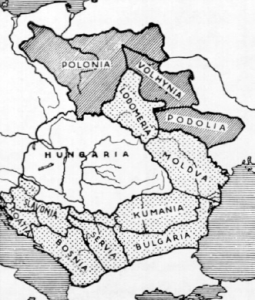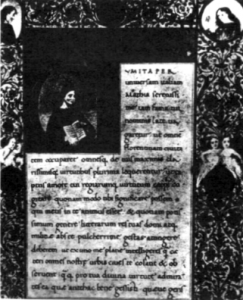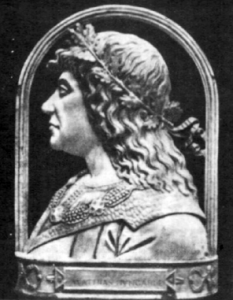Section I: History of Hungary
The Angevin and Elected Kings
The period following the death of the last Árpád king was marked by internecine wars for the crown. This era was characterized by the increasing power of the oligarchs or magnates, who literally divided the country amongst themselves and ruled over their respective territories. This era was brought to an end when Charles Robert of the House of Angevins (1308–1342), related to the Árpáds maternally, was elected king. Charles Robert and his son Louis the Great rank among Hungary’s most outstanding kings. During their reign, Hungary became a formidable European power.
King Charles Robert consolidated royal authority and curbed the power of the oligarchs. He established a monetary system based on a gold standard, which augmented the country’s power and prestige in Europe. Hungary’s chief source of wealth laid in large gold reserves in northeastern and eastern Hungary (Transylvania). The country produced a remarkable 3,000 pounds of gold annually, which represents two-thirds of the total production of the then known world. Hungary’s first gold florins were minted in 1325 and throughout Europe this stable currency based on gold was in great demand. The discovery of silver and gold mines in northern Hungary stimulated the foundation of flourishing new mining towns in what is presently Slovakia.
A new military order, based on private “bandéria”, was established. Under this system all nobles were obliged to train and equip their own militias for the purpose of defending the country.
King Louis (1342-1382), son of Charles Robert, was the only Hungarian king upon whom the nation conferred the title “Great”. He earned the title on account of his international conquests.

The territorial reign of Louis extended from the North Sea to the Black Sea and from there to the Adriatic. King Louis the Great was the acknowledged suzerein of Bosnia, Wallachia, Moldavia, Serbia, northern Bulgaria, Venice, Galicia and Lodomeria. Hungary presided Archiregnum over these territories. Moreover, Louis was elected King of Poland in 1370, following King Casimir’s death.
For over two generations, during the reign of Charles Robert and Louis the Great, Hungary was spared of serious invasion or civil war. This fact, compounded with agricultural growth and commerce, brought about economic prosperity of unprecedented proportions. The economic advantages of this era even improved the lot of the serfs: the obligations of the peasant to his lord were fixed at one-ninth of his produce and the peasants right of free migration was affirmed. Through the Law of Entail, land could not be transferred to foreign ownership. Hungary’s population reached three million with the establishment of forty-nine royal boroughs, 500 market towns and 26,000 villages.
Louis was a true patron of the arts; magnificent castles were erected at Buda, Visegrád and Diósgyor. The first Hungarian university was founded in Pécs in 1367.
The issue of throne succession once again surfaced when King Louis died, leaving two daughters. One of them, Maria, was married to Sigismund, son of the Emperor of Germany. Sigismund ascended to the Hungarian throne in 1387 and was elected Emperor of the Holy Roman Empire in 1410. Sigismund concentrated his efforts as ruler primarily in Germany; in Hungary, during his long and many absences, a Palatine was appointed to act on his behalf. The relative stability and progress of the country during this period was due largely to the advances made by his predecessors, Louis the Great and Charles Robert. There were areas, however, such as international trade, which flourished on account of Sigismund’s sphere of influence. The king stimulated manufacture, abolished internal duties, regulated tariffs on foreign goods and standardized weights and measures.
The Turkish advance in the Balkans, which presented an increasing threat to the sovereignty of Europe, directed Sigismund to lead an international expedition against the Ottoman forces in 1395. The expedition was unsuccessful and the Hungarian contingent, along with many others, was annihilated. The Balkans and ultimately all of Europe was thus exposed to attack.
Hungary’s preparedness in combatting the Turks was largely due to Sigismund’s successor, János Hunyadi, a brilliant strategist and soldier who used his personal power, wealth and prestige to secure the country’s defense. The titles and positions held by Hunyadi included: the Bán of Szorény, Voivode or ruler of Transylvania and Captain-General of Belgrade. In 1446, he was elected Regent or Governor-General of Hungary, until the boy-king, László V, came of age.
The systematic conquest of the Turks directed by Hunyadi began in Transylvania, from where they were routed in 1442. From that year forward, Hunyadi was primarily occupied with organizing a system of defense and fortifying the border system. Hunyadi succeeded in holding back the Turks, an achievement no other European leader had previously accomplished.
Janos Hunyadi’s greatest victory over the Ottoman forces was in 1456 at the Battle of Nándorfehérvár, which was so significant that the Pope ordered that all churches in Europe toll their bells everyday at noon from that day forward. The victorious army consisted of several nationalities; a large percentage were peasants recruited from villages in the countryside by a Franciscan monk, John Capistrano. Following this defeat, the Turks withdrew and did not attempt any serious invasion of Europe for over eighty years.

During the reign of King Matthias Corvinus (1458-1490), the son of János Hunyadi, the nation reached a zenith with regards to economic, cultural and military achievements. Matthias was a veritable renaissance man-as an outstanding military leader, administrator, an enlightened patron of the arts and linguist.

Matthias consolidated Hungary’s financial status, changed the system of taxation and raised revenues considerably. Towns were granted autonomous rights which stimulated further economic growth and commerce. Matthias founded a powerful standing army, the Black Army, and built a chain of fortresses in southern Hungary to counter attack by the Turks.
In 1468, Matthias was crowned King of Bohemia. He took possession of Silesia, Moravia and Lusatia and granted each autonomy under the Hungarian Constitution. Ten years later the Black Army occupied Vienna, and Matthias extended his influence over Austria and Styria.
The lot of the serf and peasant classes were improved considerably through changes made in the legal system during the reign of Matthias. The court system was modernized and countless archaic legal procedures were abrogated. An even-handed system of justice was instituted for all. Much loved by his people, Matthias often mingled among them in disguise to learn how the commoners live. Countless legends relate his experiences among the laboring classes in Hungary. The king’s advisors included commoners and many peasants and serfs were bestowed with nobility during his reign. After his death a saying was coined, which is commonly used even today: “King Matthias has died, and justice with him.”
Renaissance art and music found an appreciative patron in King Matthias. Through his wife, Beatrice of Aragon, Italian scholars, scientists, artists and writers were brought to the country. Two Italian writers, Bonfini and Galeotti, wrote a biography of King Matthias, detailing in it the spendor of the Hungarian court. Among the most famous collections in Europe, the library of Matthias, known as Corvinus, contained hundreds of illuminated manuscripts. In 1473 the first printing shop was founded at Buda. The Mátyás Coronation Church in Budapest, a monument to renaissance architecture, was initiated during his reign. Universities were founded at Pozsony (Bratislava) and Buda.
